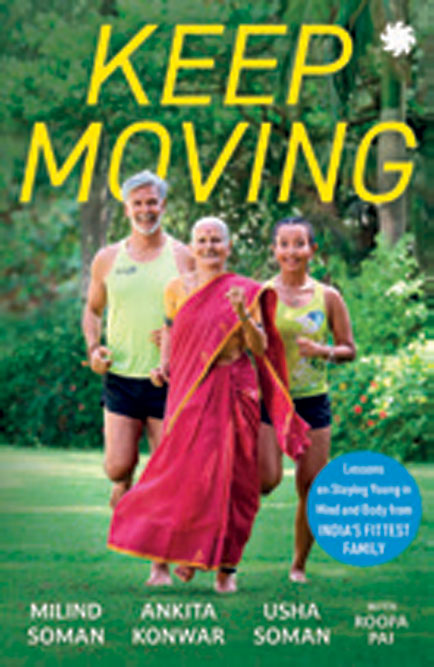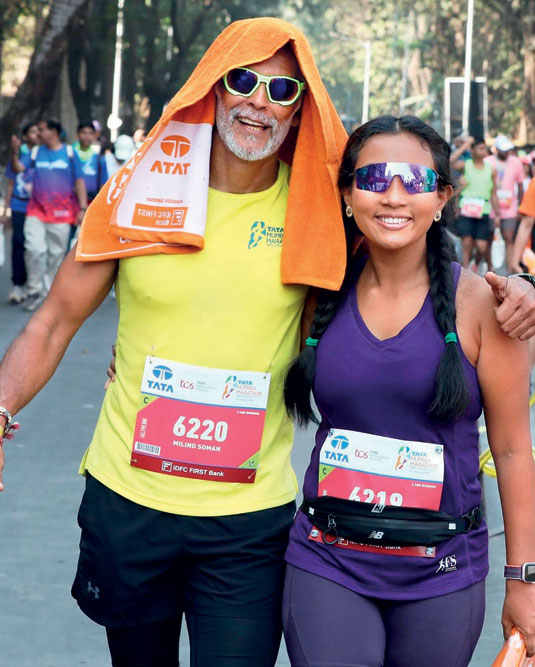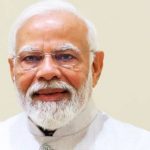Family Secret on Fitness
Milind Soman, with his wife and mother, provides the key to staying young. They talk to
 Nandini Nair
Nandini Nair  Nandini Nair
Nandini Nair  | 28 Jun, 2024
| 28 Jun, 2024

/wp-content/uploads/2024/06/Familysecrets1.jpg)
WHAT DO A department store in Tanzania, a boulevard in Switzerland, an olive orchard in Tbilisi and a pavement in Mumbai have in common? The unlikely answer is that they have all been venues for 58-year-old Milind Soman’s PushUpsForSelfie movement. Men, women, even children, get down on the ground and show off their upper-body strength (or lack thereof) to Milind, who has over the years made his own fitness a requirement, and the fitness of others a mission. One need only browse his social media to see how health for him is not a matter of gyms, supplements or sundry other exertions and deprivations, rather it is about an active lifestyle and a simple diet, which includes a staggering amount of fruits (an entire watermelon and one whole papaya at breakfast are the norm).
Joining him in this noble mission are his mother, Usha Soman, and wife, Ankita Konwar. If one were to Google Usha, the first images that pop up of the octogenarian are of her jogging in a sari, cycling on a beach and holding the plank position. Like her husband, Ankita’s social media is also awash with images of her running, trekking, diving and doing yoga. Given the wholesome pursuits of the family, the threesome is now out with a book, Keep Moving: Lessons on Staying Young in Mind and Body from India’s Fittest Family (with Roopa Pai; Juggernaut; 207 pages; ₹399). With their adherence to consistency, discipline, uncluttered thinking, healthy eating and constant movement they’ve ticked many impressive boxes. Milind and Ankita have run marathons across the globe, Milind completed the Ultraman Florida Challenge in 2017, together they founded Pinkathon to inspire women to walk/run, and Usha at the age of 81 completed the 52km Sandakphu-Phalut winter trek.
Keep Moving could easily have descended into a ponderous self-help book about how to achieve peak fitness. But to its credit, it reads more like a letter from an ally instead of an instruction manual from a guru. It has a lightness, which ensures that it can be read in a couple of hours. (It is, however, at times, guilty of a surfeit of exclamation marks.) The Somans do not make fitness a destination, instead they make it commonplace. Fitness should be as fundamental to one’s daily schedule as eating and drinking. The book is aimed at different age demographics, and it helps that Milind’s mother is 26 years older than him and his wife is 26 years younger. Each of them has incorporated fitness into their lives in a different yet an organic way. As Pai writes in the Introduction, “the trick,” “if there is such a thing, is to keep moving—moving on from past regret, moving forward towards the next adventure, moving old ideas along to accommodate new ones, moving your goalposts, moving your limbs.” Through the biographies of the Somans we learn the importance of— “Fight lazy, keep moving!”
“We have accomplished whatever we have only through introspection. It is only through personal experience and through personal learning that we have evolved our own systems of being healthy and fit, and that is the most sustainable way to be healthy and fit,” says Milind Soman, actor and fitness evangelist
Milind’s engagement with sport far predates his forays into entertainment, he started swimming at six, and was a national swimmer in the 1980s. As he says in Keep Moving, “Four years as national swimming champion had brought me very little recognition or adulation from the general public. But one ad, featured on a giant billboard outside the old Cadbury House on Bombay’s Pedder Road [in 1989] changed all that.” His leonine features, lustrous hair, and sculpted physique would have ensured his posterity. But he still stood out from the model crowd, whether it was his bare-chested veshti-clad appearance in Alisha Chinai’s ‘Made in India’ or his Tuff shoes ad with his then girlfriend Madhu Sapre where both were dressed in nothing but a pair of shoes and a python, or his debut in Mouthful of Sky, the first serial in English to be produced in India. With Keep Moving Milind cashes in on the appeal he has built over the decades and proves how looking good and being healthy are two sides of the same coin.
When I speak to the Somans on a Zoom call, each of them signs in on a separate device. Usha’s camera is not working, so I am unable to see her, while Milind and Ankita are perfectly camera ready. During the interview, Usha is the most reticent, while Milind crafts paragraph after paragraph of quotable quotes. Milind often encourages her to speak, but “Aai” (‘mother’ in Marathi) usually laughs and leaves the answering to the other two. Milind says that the book aims to chronicle how three of them from different age groups (30s, 50s and 80s) have arrived at the same objective “which is being fit and being healthy and being able to enjoy life to the fullest.” They chose to make the book illustrative rather than didactic. He explains, “People just follow us by example saying, ‘If they can do it, then we can do it.’ We have accomplished whatever we have only through introspection. It is only through personal experience and through personal learning that we have evolved our own systems of being healthy and fit, and that is the most sustainable way to be healthy and fit and that’s what we want people to know.”

Keep Moving is a decent yarn in itself as it also details the various ups and downs of its characters. While Pai has previously chronicled the making of Milind in his biography Made in India (2020), here too we glimpse his party days and encounters with his old “favourites”— marijuana and coke. Addled by intoxicants, he once missed a major fashion show. Repentant—he abandoned alcohol and drugs overnight. We learn of Ankita’s traumas, the death of loved ones, and the clouds of depression and despair that followed. We read of Usha the child realising that she has a stepmother overnight, and her own struggles raising four young children abroad. I ask them if it was easy to speak about such trying times. Ankita, who grew up in a “small, remote town of North Lakhimpur, some 400 kilometres northeast of Guwahati,” says that she always wanted to be a writer and so was unsure initially about trusting her story to someone else’s pen. But then Pai’s questions won her over and she came to believe in the process. Milind adds to this, “It was not an easy book. It is not an easy book. It’s neither a self-help book which tells you what to do, stepwise, which is what normally happens. Neither is it a hero story, where something really bad has happened to somebody and they’ve overcome it and they have succeeded. This book is not like that. It’s a book of evolution.” Flicking his mane from his forehead, he adds, “But it is also inspirational because we’ve done things that people think are extraordinary, but in an ordinary way because we’ve taken it very gradually.”
“If you do not challenge yourself every day, consciously create small challenges for yourself, your body begins to get weaker and weaker. That is not something that’s instinctive. Instinctive is to eat things that the body craves, which is what the big food industries depend on—salt, fat and sugar,” says Milind Soman
While the Somans clearly share a love for fitness and the outdoors, Keep Moving also reveals their need for solitude and their common love for nature. As a child, Glasgow-born Milind was at first a misfit in his almost all-white kindergarten in Hertfordshire. He then returned to Bombay as a child with a foreign accent and was soon picked upon. The library and swimming pool became his refuge away from bullies. And in essence away from human conversations and interactions. Ankita grew up in boarding schools, her one constant being her summer vacations at her maternal grandfather’s village. Here she climbed trees, rode her bicycle, killed her first chicken at age 10, and learned all about the flora and fauna. Even today the three of them cherish time on their own and their connection to the earth. Milind says, “Being comfortable with solitude is like a superpower. People think that it’s not a good thing to be alone—you might be lonely, but I think it’s a great thing.” He recalls how swimming was the perfect escape for a shy child as it allowed him to hear nothing, see nothing, other than the water in front of him and his own movement in it. He feels he has stuck with sport unlike so many of his contemporaries who dropped out and “became fat” because he has continued to nurture this solitude. After her sylvan childhood, Ankita became an air hostess and was quickly thrown into a very “crowded world”. Over the years, she has used running and yoga to centre herself. Today she is happy to carve out time on her own, and asserts, “Time with myself is like a party, I love it.” When Milind and Ankita first met a decade ago, Ankita was just 22. Their common appreciation for nature (even their proclivity to be barefoot) was an instant connection. Having spent much of her childhood on a farm in the Northeast, she says, “I was so drawn to Milind because he was so one with the earth. He understood it. He didn’t feel like he was from the city, or he had to learn about it. He knew that he’s a part of it. And it’s a part of him.” Usha also takes an interest in the outdoors, and goes for tree walks in Shivaji Park, which is near her home of 50-plus years.
Having completed marathons all over the world, it would be safe to say that Milind and Ankita are at peak fitness. But their extraordinary feats are achieved by rather ordinary daily schedules. Milind’s main daily fitness routine involves a short run and multiple sets of push-ups. He states in the book, “On most days, it is just pull-ups and the push-ups, a total daily workout of 3 to 7 minutes max!” Given how simple they make fitness sound, I ask them why more of us do not make it a priority in our lives. Milind has an apt theory; “As technology started getting more and more sophisticated, it became easier and easier and more and more comfortable for us to survive. But comfort and ease are not necessarily what we need. What we need, what we evolved for, even mentally and physically is to challenge the human body. Without challenge, we disintegrate. If you do not challenge yourself every day, consciously create small challenges for yourself, your body begins to get weaker and weaker. Your mind begins to get weaker and weaker, but we don’t know that. It is not something we’re taught. That is not something that’s instinctive to know. Instinctive is to eat things that the body craves, which is what the big food industries depend on—salt, fat and sugar.” Keep Moving thus has a rather simple lesson—take the stairs, not the escalator, walk to the neighbourhood shop, don’t drive, spurn packaged food, and just don’t be stationary. While being active if you succeed at completing a marathon—all power to you.
I finally ask the Somans if the title “India’s Fittest Family” is a heavy burden to bear. Milind is quick to say that he believes in carrying no burdens. Usha lays all doubts to rest, when she replies, “You’re not doing things to inspire people. People get inspired by what you are doing, so that can’t be a burden to you.”

/wp-content/uploads/2024/10/LawrenceBishnoi.jpg)








/wp-content/uploads/2024/10/GreenPioneer1.jpg)
/wp-content/uploads/2024/10/Gandhi1.jpg)
/wp-content/uploads/2024/10/Socialism1.jpg)

More Columns
‘AIPAC represents the most cynical side of politics where money buys power’ Ullekh NP
The Radical Shoma A Chatterji
PM Modi's Secret Plan Gives Non-Dynasts Political Chance Short Post